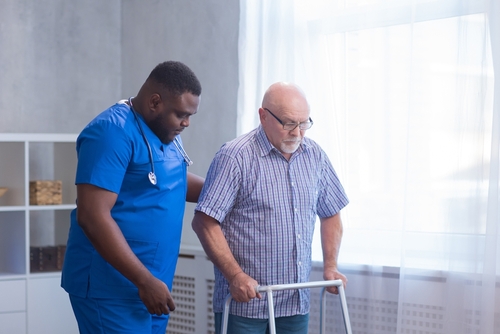The United States will need to fill nearly three-quarters of a million open jobs for home health and personal care aides every year through 2031. Currently, immigrant workers fill these jobs in outsized numbers. Without more workers joining the workforce, the drastic shortage of aides could leave millions of Americans without the ability to remain in their homes when they’re in need of long-term care.
Soaring Need for Aides
An analysis of U.S. Bureau of Labor Statistics (BLS) data by the American Immigration Council shows that the home health and personal care aides occupation is one of the fastest growing jobs. It’s estimated that an average of 711,700 jobs will open up every year from 2021 to 2031.
This is largely driven by the unprecedented growth of the senior population in this country. About 10,000 baby boomers turn 65 every day, and 7 in 10 will need long-term care in their lifetime. The number of Americans over the age of 85 is expected to more than double from 2019 to 2040, from 6.6 million to 14.4 million.
As a result, the number of home health and personal care aide jobs is expected to jump 25.4% in a decade, from 3.6 million in 2021 to 4.6 million in 2031. This occupation will experience the largest increase in new jobs of any occupation in that period and will become the largest occupation in the country by 2031.
Critical Shortage of Caregivers
Despite the growing demand for the workforce, the country’s pool of available workers will barely grow. It is estimated that the number of prime working-age Americans, those between the ages of 25 and 64, will increase by a meager 0.3% a year through 2035— and only because of arriving immigrants and their children.
From 2021 to 2031, a projected 332,300 home health and personal care aides will drop out of the workforce each year for retirement or other reasons. In addition, 287,000 home health and personal care aides a year can be expected to abandon the occupation in search of other work. This demanding job has turnover rates that exceed nearly every other occupation.
A Council analysis of jobs postings aggregated by Lightcast finds that although the position does not require an academic degree or licensure, it demands a broad range of physical, psychological, and emotional skills, including being able to safely transfer people and dealing with Alzheimer’s patients.
Aides suffer from higher-than-average injury rates and cite high stress and low pay. Home health and personal care aides earn less than just about every other healthcare support occupation, BLS data shows. In 2021, the median annual wage for home health and personal care aides was $29,430, or $14.7 per hour for full-time work.
Helping Immigrants Help Us
Most seniors and disabled people would prefer to stay at home—an option that also costs the nation less than housing people in nursing homes. But as more Americans age, many will not be able to stay in their home unless we can attract more workers to serve as home health aides.
During the pandemic, home health aides were in particularly short supply, painting a grim picture of what could lie ahead for Americans.
Bayada Home Health Care, which provides services in 350 locations in 22 states, told Home Health Care News that they had to decline nearly two-thirds of new home-care requests due to the shortage of available aides.
Efforts are already underway in some states to mandate higher wages, such as the Fair Pay for Home Care campaign in New York and the Caregiver Stabilization Act in Minnesota. And the U.S. Department of Health and Human Services announced in 2022 that states would have until 2025 to access $12.7 billion from the American Rescue Plan Act to strengthen home and community healthcare services for Medicaid recipients to, in part, “reduce unnecessary reliance on institutional care.”
Such policies are particularly important for immigrant workers, who are already playing an outsized role in providing care for our senior and disabled population.
In 2019, 36.5% of all home health aides in the United States were immigrants, a rate that was twice their share of the U.S. workforce overall (17.1%). This includes undocumented workers, who made up an estimated 6.9% of home health aides and 4.4% of personal care aides.
We need immigration policies that can attract and provide support for more foreign-born health aides. This will prove to be critical in securing the much-needed care of our aging population in the years to come.

